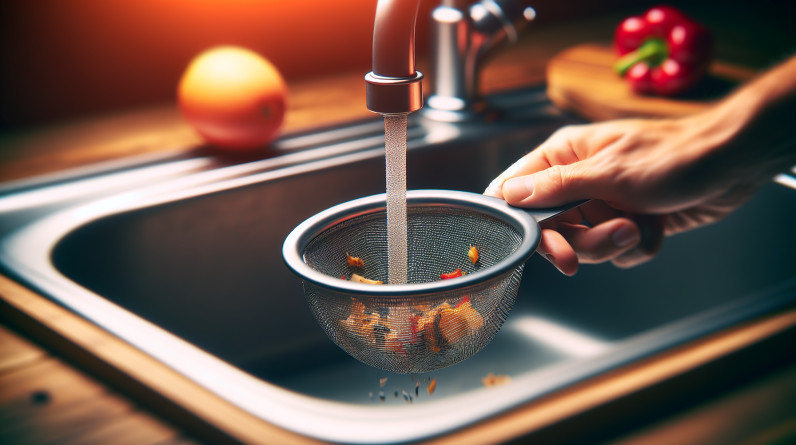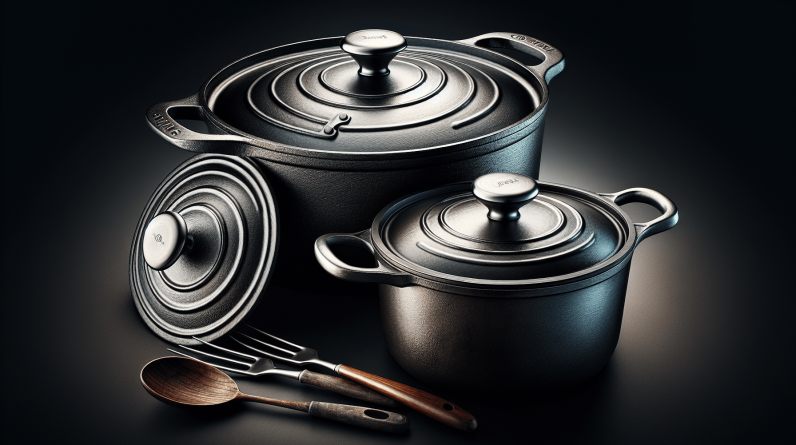Are you looking for ways to make your kitchen more environmentally friendly? Look no further! In this article, we will share some simple yet effective tips on how to create an eco-friendly kitchen. From using energy-efficient appliances to reducing food waste, we have got you covered. By implementing these practical suggestions, not only will you be contributing to a healthier planet, but you will also enjoy the benefits of a more sustainable lifestyle. So, let’s get started on transforming your kitchen into an eco-friendly haven!
Energy Usage
Switch to energy-efficient appliances
One of the most effective ways to make your kitchen more environmentally friendly is by switching to energy-efficient appliances. These appliances are designed to use less energy than their traditional counterparts, which not only helps reduce your carbon footprint but also saves you money on your energy bills. Look for appliances with the Energy Star label, as these have been certified to meet strict energy efficiency standards. From refrigerators and dishwashers to stoves and ovens, there are a wide range of energy-efficient options available on the market today.
Use natural lighting
Another simple way to reduce your kitchen’s energy usage is by utilizing natural lighting as much as possible. During the day, open up your blinds or curtains to let the sunlight in. Natural light not only creates a warm and inviting atmosphere in your kitchen, but it also eliminates the need for artificial lighting. By relying less on electric lights, you can significantly reduce your energy consumption. Consider installing skylights or larger windows to maximize the amount of natural light that enters your kitchen.
Consider installing solar panels
If you’re ready to take your kitchen’s energy efficiency to the next level, consider installing solar panels on your roof. Solar panels harness the power of the sun to generate electricity, providing a renewable source of energy for your home. By making use of solar power, you can drastically reduce your reliance on fossil fuels and decrease your carbon emissions. While the initial cost of installing solar panels may seem steep, the long-term savings and environmental benefits make it a worthwhile investment.
Water Conservation
Install a low-flow faucet
Water conservation is another essential aspect of creating an environmentally friendly kitchen. One of the simplest ways to limit water usage is by installing a low-flow faucet. These faucets are designed to use less water without compromising on performance. By reducing the flow of water, you can save significant amounts of water over time. Look for faucets with a WaterSense label, which indicates that they meet the strict water efficiency standards set by the Environmental Protection Agency (EPA).
Fix any leaks
Even small leaks can add up to substantial amounts of wasted water over time, so it’s important to promptly fix any leaks in your kitchen. Check your faucets, pipes, and dishwasher for any signs of leakage and repair them as soon as possible. Not only will this conserve water, but it will also prevent damage to your kitchen and save you money on costly water bills.
Use a dishwasher with an energy-saving mode
Using a dishwasher may seem counterintuitive to water conservation, but modern dishwashers are actually more efficient than washing dishes by hand. Look for a dishwasher with an energy-saving mode, which uses less water and energy to clean your dishes. Load the dishwasher to its full capacity before running a cycle to make the most out of each use. By using an energy-saving dishwasher and avoiding unnecessary hand washing, you can save both water and energy in your kitchen.
Reduce Waste
Start composting
One of the most effective ways to reduce waste in your kitchen is by starting a composting system. Composting allows you to dispose of organic waste, such as vegetable scraps and coffee grounds, in a way that transforms it into nutrient-rich soil. Instead of sending these materials to the landfill, where they contribute to greenhouse gas emissions, you can turn them into valuable compost for your garden. Invest in a compost bin or create a compost pile in your backyard, and be sure to follow proper composting practices to ensure optimal decomposition.
Use reusable bags and containers
Another way to minimize waste in your kitchen is by using reusable bags and containers instead of disposable ones. When grocery shopping, bring your own cloth bags or sturdy reusable bags to carry your purchases. Avoid plastic bags whenever possible. Additionally, opt for reusable food containers for storing and packing food, instead of single-use plastic bags or wraps. By choosing reusable options, you can significantly reduce the amount of waste that ends up in landfills.
Buy in bulk to minimize packaging
When shopping for kitchen supplies, consider buying in bulk to minimize packaging waste. Bulk items typically come in larger quantities and use less packaging compared to individually wrapped or single-use products. Bring your own reusable containers and bags to the bulk section of your grocery store and stock up on pantry staples like grains, nuts, and spices. Not only does buying in bulk reduce packaging waste, but it can also save you money in the long run.
Sustainable Materials
Choose eco-friendly countertops
When renovating or remodeling your kitchen, opt for eco-friendly countertops made of sustainable materials. Natural materials like bamboo, cork, and recycled glass are all great options that are not only aesthetically pleasing but also better for the environment. These materials are renewable, biodegradable, and produce less waste during the manufacturing process compared to traditional countertop materials like granite or quartz. Additionally, seek out countertops that have been certified by reputable organizations, such as the Forest Stewardship Council (FSC), to ensure they meet sustainability standards.
Opt for bamboo or cork flooring
In addition to countertops, selecting eco-friendly flooring materials can make a significant impact on the sustainability of your kitchen. Bamboo and cork flooring are both excellent choices as they are renewable resources that grow quickly and can be harvested without causing significant environmental damage. Bamboo and cork also have natural properties that make them durable and resistant to moisture, making them ideal for kitchen environments. By opting for these sustainable flooring options, you can reduce the demand for traditional hardwoods that take longer to replenish.
Use non-toxic paint and finishes
When painting or refinishing your kitchen cabinets or walls, opt for non-toxic paint and finishes. Traditional paints often contain harmful volatile organic compounds (VOCs) that can release toxins into the air, contributing to poor indoor air quality and potentially harming the environment. Look for paints labeled as low or zero VOC, which have significantly lower levels of harmful emissions. By choosing non-toxic paint and finishes, you can create a healthier kitchen environment and minimize your ecological footprint.
Reduce Chemicals
Make your own cleaning products
Many conventional cleaning products contain harsh chemicals that can be harmful to both your health and the environment. Instead of relying on these products, consider making your own natural cleaning solutions using simple ingredients like vinegar, baking soda, and lemon juice. These ingredients are effective at removing dirt and grime while being non-toxic and biodegradable. With a few basic ingredients and some DIY recipes, you can easily create your own eco-friendly cleaning products that are just as effective as store-bought alternatives.
Eliminate chemical air fresheners
Air fresheners often contain a variety of synthetic fragrances and chemicals that can contribute to indoor air pollution. Instead of relying on these chemical-laden products to freshen up your kitchen, opt for natural alternatives. Open the windows to let in fresh air, light scented candles made from soy or beeswax, or use essential oils with a diffuser to add a pleasant aroma to your kitchen. These natural alternatives not only eliminate the harmful chemicals found in air fresheners but also provide a more soothing and therapeutic experience.
Use natural pest control methods
Instead of resorting to chemical pesticides to control pests in your kitchen, consider using natural pest control methods. For example, place traps or catchers to capture insects, and use deterrents like peppermint oil or citrus peels to repel pests. These methods are safer for your health, as well as the environment. Additionally, keeping your kitchen clean and properly storing food can help prevent pest infestations in the first place. By adopting natural pest control practices, you can effectively eliminate pests while minimizing your exposure to harmful chemicals.
Reduce Food Waste
Plan meals and create a shopping list
One of the primary causes of food waste in the kitchen is inadequate meal planning. Before grocery shopping, take the time to plan your meals for the week and create a detailed shopping list. This will help you purchase only what you need and avoid impulse buys that often end up going to waste. Consider taking inventory of the ingredients you already have at home and incorporate them into your meal plans. By planning your meals and shopping strategically, you can significantly reduce food waste in your kitchen.
Properly store leftovers
Properly storing leftovers is crucial to prevent food waste. Invest in airtight food containers or reusable wraps to store any remaining food. Label the containers with the date to ensure you use the oldest leftovers first. Additionally, organize your refrigerator to keep track of what needs to be consumed. By storing leftovers properly, you can extend their shelf life and ensure they are still safe to eat when you’re ready to enjoy them.
Donate excess food to local food banks
If you find yourself with excess food that cannot be consumed before it spoils, consider donating it to local food banks or community organizations. These organizations collect and distribute food to those in need, reducing food waste while providing support to individuals and families facing food insecurity. Contact your local food bank or community center to find out their donation guidelines and help make a positive impact in your community.
Save Water
Only run the dishwasher when it’s full
Running the dishwasher only when it’s full is a simple yet effective way to save water in the kitchen. Avoid running partial loads, as this results in unnecessary water consumption. By waiting until the dishwasher is completely full before running a cycle, you can maximize the efficiency of each use and reduce water waste. Additionally, consider using the energy-saving mode on your dishwasher, if available, to further minimize water and energy usage.
Don’t let the tap run while washing dishes
When washing dishes by hand, be mindful of your water usage. Avoid letting the tap run continuously while scrubbing or rinsing dishes. Instead, fill up the sink or a basin with water for washing and rinsing. This simple step can save a significant amount of water compared to leaving the tap running. Additionally, using a dual-function faucet aerator can help regulate water flow and provide adequate pressure while conserving water.
Use a water-efficient dishwasher detergent
Choosing a water-efficient dishwasher detergent can further reduce water usage in your kitchen. Look for detergents that are specifically designed to perform well in water-saving dishwashers. These detergents help optimize the cleaning process and minimize the need for excessive rinsing or additional cycles. Using a water-efficient dishwasher detergent not only saves water but also ensures that your dishes come out clean and sparkling.
Conserve Energy
Unplug appliances when not in use
Many appliances continue to draw power even when they are not in use, known as standby power or “vampire” power. To conserve energy in your kitchen, make it a habit to unplug appliances when they are not actively being used. This includes small appliances like toasters, blenders, and coffee makers, as well as larger ones like microwaves and ovens. Alternatively, you can use power strips with an on/off switch to easily turn off multiple appliances at once.
Use energy-saving cooking methods
When cooking in your kitchen, there are several energy-saving methods you can employ. Opt for smaller appliances like toaster ovens or slow cookers instead of using the larger oven whenever possible. Use the appropriate-sized cookware for your stovetop burners to maximize efficiency and prevent heat loss. Additionally, consider using lids on pots and pans to retain heat, reduce cooking time, and ultimately save energy. By implementing these energy-saving cooking methods, you can minimize energy consumption while still enjoying delicious meals.
Invest in energy-efficient lighting
Switching to energy-efficient lighting fixtures and bulbs is an excellent way to conserve energy in your kitchen. Replace traditional incandescent light bulbs with energy-saving LED bulbs, which use significantly less energy and have a much longer lifespan. LED lights not only reduce your energy consumption but also produce less heat, making your kitchen more comfortable during hot summer months. Additionally, consider installing motion sensors or timers to automatically turn off lights when the kitchen is not in use, further reducing unnecessary energy usage.
Improve Indoor Air Quality
Invest in a range hood for better ventilation
Proper ventilation is essential for maintaining good indoor air quality in your kitchen. Investing in a range hood can help remove smoke, odors, and airborne pollutants that are generated during cooking. The range hood should be properly sized to effectively capture and exhaust the pollutants. It’s also crucial to regularly clean and maintain the range hood filters to ensure optimal performance. By improving ventilation, you can reduce the buildup of indoor air pollutants and create a healthier living environment.
Keep plants in the kitchen
Adding houseplants to your kitchen can help improve indoor air quality by naturally filtering and purifying the air. Plants absorb harmful gases and release oxygen, creating a healthier atmosphere. Some excellent plant choices for the kitchen include peace lilies, spider plants, and aloe vera. Not only do these plants improve air quality, but they also add a touch of greenery to your kitchen, creating a more vibrant and refreshing space.
Avoid using harmful chemicals
To further improve indoor air quality, avoid using harmful chemicals in your kitchen. Many cleaning products, pesticides, and air fresheners contain volatile organic compounds (VOCs) that can contribute to indoor air pollution. Instead, opt for natural alternatives like vinegar, baking soda, and essential oils. Additionally, be mindful of the chemicals used in cookware and utensils. Choose non-toxic and eco-friendly options to minimize exposure to harmful substances. By avoiding the use of harmful chemicals, you can create a safer and healthier kitchen environment for you and your family.
Choose Sustainable Foods
Buy organic and locally sourced produce
When it comes to selecting sustainable foods for your kitchen, prioritize organic and locally sourced produce. Organic farming practices minimize the use of synthetic pesticides and fertilizers, which reduces the impact on the environment and ensures a healthier end product. Locally sourced produce eliminates the need for long transportation routes, reducing greenhouse gas emissions associated with food transportation. Visit local farmers’ markets or join a community-supported agriculture (CSA) program to access a wide range of fresh and sustainable produce.
Reduce meat consumption
The production of meat, particularly from resource-intensive livestock like cattle, has a significant impact on the environment. To make your kitchen more sustainable, consider reducing your meat consumption and incorporating more plant-based meals into your diet. Plant-based proteins like legumes, tofu, and tempeh are not only environmentally friendly but also offer numerous health benefits. Experiment with vegetarian and vegan recipes that are delicious and nutritious. By reducing meat consumption, you can reduce greenhouse gas emissions, conserve water, and contribute to a more sustainable food system.
Support sustainable fishing practices
If seafood is part of your diet, it’s essential to support sustainable fishing practices. Overfishing and destructive fishing methods can deplete fish populations and harm fragile marine ecosystems. Look for seafood that is certified by reputable organizations like the Marine Stewardship Council (MSC) or the Aquaculture Stewardship Council (ASC). These certifications ensure that the seafood has been sourced sustainably and responsibly. Additionally, be mindful of the seasons when certain types of seafood are abundant and opt for local, wild-caught options whenever possible.
By adopting these environmentally friendly practices in your kitchen, you can significantly reduce your ecological footprint and create a more sustainable living space. From saving energy and water to reducing waste and supporting sustainable food choices, every small step matters. So start implementing these changes today and make a positive impact on the environment while enjoying a beautifully green and environmentally friendly kitchen.









